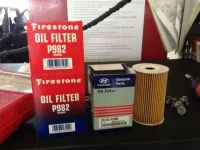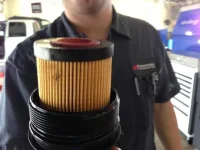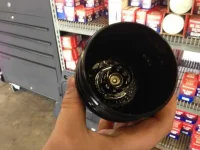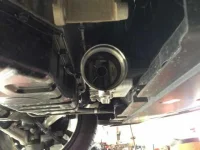Speculation. As I said,
you were the one who quoted a 10 yr old test making the disparaging claims. You seem to have all the answers, so please, contact K&N, make your claim and and ask them and you can post their response to you. I'm sure others would love to see it as well. And I'd love to see documented facts that the use of a K&N filter 'destroyed' an engine. I would wager to say that for every anecdotal story of a 'destroyed' engine, there are thousands of anecdotal stories, like mine, that support the fact that no K&N filter has
destroyed an engine.
I've used K&N filters for years and years - decades I guess, if you count the other vehicles I've had. The ONLY way you could 'mess up' a MAF sensor is to totally and stupidly
exceed the wetting instructions..."When servicing a K&N filter, take care not to over-oil the element. Besides impeding air flow, excess oil can migrate into the intake system where it can coat electronic sensors, which some OEM’s claim may hinder the sensors’ operation and result in a repair that will not be covered under warranty. Although K&N disagrees with such claims, as explained in more detail on this web site, in order to avoid a dispute with an OEM over the denial of a warranty claim, we suggest that you be careful not to over-oil your K&N air filter.
Never saturate the filter. If oil drips from the filter, wash it and start over.
Use only K&N oil. For example, an E-1500 filter has 92.4-inches of surface area requiring 1.707 fluid ounces of oil. Follow oiling instructions included with your filter or refer to the instructions listed here."
I use K&N filters NOT for 'increased' HP or whatever. I use them because overall I
SAVE money, and I can keep a
cleaner air filter in my engine as I clean my filters
twice a year. A 24 yr old Isuzu Pickup truck that I've owned since it had 15 miles on the odometer, and now has 204,000 miles on it, USING K&N air filters, speaks for itself. And from March 1990 until last August (amost 24 years), that truck was with me in SE
Arizona, one of the dustiest places around. Yet no engine wear, even though it saw daily use in a pretty tough environment off road - on many dirt and gravel roads. It burns no oil, has 21" of vacuum at idle, and gets me 22.8 mpg. So yea, I'm VERY happy with K&N filters and will continue to use them. My 2012 Genesis, 1990 Isuzu Pickup, 2004
GMC Envoy (5.3L) and Suzuki motorcycle all run very fine with them. I'd put one on my John Deer Tractor if they made one for it.
Oh, and I'm not a 'disguised K&N employee'. Just a very happy and satisfied customer.
..."The quality of an air filter can only be judged by reviewing all four important characteristics.
1) Restriction while loading with dust; 2) Filtration efficiency as a percentage; 3) Dust holding capacity before the filter needs cleaning or replacement ; and 4) filter life. Any company designing an air filter must make choices about these four characteristics and how their filter will perform in each area. Generally speaking, each characteristic of an air filter has an
inverse relationship to at least one of the others, meaning, as filtration efficiency goes up, restriction increases and capacity or service life decreases. So an air filter manufacturer can design an air filter to have ultra high filtration efficiency by compromising the filters restriction, capacity, and/or service life. We judge the quality of an air filter based upon the proper balance of these four essential criteria.
Maximizing one at the expense of others sounds more like a marketing goal rather than an engineering goal. So the basic answer to the original question is that
higher filtration is not necessarily a good thing when it comes at the expense of restriction, reusability and/or capacity. While the benefits of a filter with 99.9% filtration are unknown, the benefits of low restriction are measurable and clear. Low restriction helps an engine perform more efficiently generating more power and torque.
That would lead a reasonable person to ask: What then is a safe level of filtration? This question is literally unanswered.
Minimum air filter specifications are generally not called out in vehicle owners' manuals, nor will you find much published information on air filtration requirements from vehicle manufacturers. We have never seen a scientific study concluding what levels of filtration efficiency correspond to various levels of engine wear. Some large air filter companies do not even publish information on the efficiencies of the air filters they manufacture. It is K&N's opinion that both the Fine and Coarse Test Dust mixtures used in air filter testing contain such a high concentration of small particles that even filtration efficiency numbers as low as 90% may provide adequate engine protection. Remember that almost 11% of COARSE test dust is smaller than 5.5 microns (the size of a red blood cell).....While there are few if any studies on engine wear, it
would seem reasonable to speculate that particles less than 5.5 microns create little engine wear unless ingested at very high levels of concentration. As support for this theory, consider the filtration levels provided by fuel filters and oil filters that sometimes tout their ability to filter particles above 10 or 20 microns.
If you really want to compare two air filters, you need to know all four characteristics mentioned above. Consumers can then choose what matters most to them.
We design air filters to provide low restriction throughout the filter's service interval. We seek the
best balance between airflow and filtration recognizing they are inversely related. After nearly
40 years in business with millions of air filters sold, we have a track record you can trust and the experience that can only be earned through years of focusing on just one thing. But even our experience is not enough. We operate a fully staffed air filtration lab that operates on a year round basis with two test stands. The lab was designed by Southwest Research and is calibrated regularly to ensure our test results are reliable. This testing is an essential ingredient in verifying our air filters meet our own high standards of excellence. Making a great air filter is no accident and we are confident our air filters provide outstanding engine protection with huge air flow advantages throughout the air filter's service interval. That's why we back up our replacement air filters..."
and
"Out of the millions of air filters we sell, we only receive a handful of consumer complaints each month that a dealership or service provider has blamed a vehicle sensor repair on our product. We take each complaint very seriously and see it as an opportunity to stop a consumer from being taken advantage of.
We investigate the situation thoroughly and take full responsibility for resolving the issue. For more information on how we educate and persuade the service provider to reconsider their position, see Mass Air Flow Sensor Information & Testing. We are so confident in our ability to resolve these situations and to help a consumer fight back that we offer our Consumer Protection Pledge.
As a result of our standing up for consumer rights and providing assistance to resolve a disagreement, we have had over 300 actual sensors sent to us by dealerships who claimed our product had caused them to fail.
Microscopic, electronic and chemical testing revealed that none of the sensors were contaminated by K&N oil (K&N Detailed MAF Sensor Test Results). What is perhaps the single biggest clue to what is going on is that over 50% of these sensors were not broken in the first place for any reason.
and K&N also backs up their claims:
http://www.knfilters.com/warranty.htm
That's pretty strong from a company that produces a product that SUPPOSEDLY 'destroys' engines.

This could be fun---------again. I went several rounds with (I think) a disguised K&N employee on another forum (Corvette) a few years ago. He finally gave up.
First, they appear to be lying in their response to you. The originator of the original test (Mr. Spicer) did respond to their original inquiries and actually visited the K&N facilities. While there, tests were rerun. You can see the whole visit here:
http://www.dieselplace.com/forum/3-power-performance/84-fuel-system-air-exhaust-emissions-upgrades/66536-k-n-report.html
Not surprisingly, K&N's filter did better---------------but not very well. At K&N's facility, the K&N filter got a 98.4% efficiency there vs 96.8% at the independent test site. Sounds good until you remember that the OEM paper filter got a 99.93% rating. That means that the K&N (at the K&N test site) let 22.8% more dirt through than the paper filter!!!!!
One of the key things to a K&N filter (or any oil-wetted filter) is that the efficiency improves as the filter "loads" with dirt. So K&N starts their tests with a very low rate of dirt feed. Spicer's original tests had a steady rate and higher dirt feed rate.
Spicer's test also used a variable air flow while K&N uses a fixed air flow. The variable flow (much more reflective of a car's operation) can break previously captured dirt particles loose from a filter (probably more likely with an oil-wetted filter than a paper filter).
As for anecdotal stories of good results with oil-wetted filters, do what you want. There are also lots of anecdotal stories about messed up MAF sensors and engines that wear out quicker.
It's your engine and your pocket book, do as you please, but try to do it well informed.
















